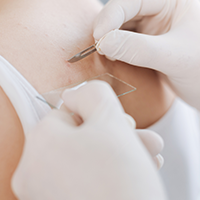Last updated: November 2023
Also known as: Apthae, recurrent aphthous stomatitis (RAS), recurrent oral aphthae, mikulicz ulcers, sutton’s ulcer, periadenitis mucosa necrotica recurrens (PMNR), canker sores, simple or complex aphthosis, non-sexually acquired genital ulceration (NSGU)
What are aphthous ulcers?
Aphthous ulcers are common ulcers of the oral mucosa, and present as a painful sore on oral or genital mucous membranes. They can be classified as simple, complex or non-sexually acquired genital ulceration (NSGU).
Who gets aphthous ulcers?
Aphthous ulcers are common. They affect between 5% and 25% of the Australian population, and are more common in adolescents and men. 1
Individuals living in high socioeconomic areas are more likely to develop aphthous ulcers.
What causes aphthous ulcers?
The exact cause of aphthous ulcers is unknown. Approximately 40% of individuals who get aphthous ulcers have a family history of aphthous ulcers. 2 A weakened immune may also play a role in the development of aphthous ulcers.
Some other factors that trigger an outbreak of aphthous ulcers may include:
- Trauma
- Vitamin deficiencies – such as iron, folate or vitamin B1, B2, B6 and B12 deficiencies
- Hormonal fluctuations – such as menstruation and pregnancy
- Toothpastes containing sodium lauryl sulphate
- Smoking cessation
- Psychological stress
- Infections
- Medication allergy – such as nicorandil
- Food hypersensitivities
- Genetic factors
- HIV infection
- Gluten sensitivity or Coeliac disease
What do aphthous ulcers look like?
Aphthous ulcers are often round, shallow and painful with a creamy-white or grey film and red halo. They occur predominantly in the skin inside the mouth but can also occur in the genital areas.
Individuals may experience a single or multiple ulcers.
Aphthous ulcers are classified into three categories:
- Simple aphthous ulcers: These are the most common type of aphthous ulcer and have three main types.
- Minor aphthous ulcers, also known as Mikulicz ulcers, usually first appear in childhood or adolescence. The ulcers are usually shallow, less than 5 mm in size and heal within 1 to 2 weeks.
- Major aphthous ulcers, also known as Sutton’s ulcers, usually appear in childhood or adolescence. The ulcers are usually 1 to 3 cm in size and take about 6 weeks to heal and leave a scar.
- Herpetiform aphthous ulcers usually appear in young adults. There are usually multiple ulcers between 1 to 2 mm in size and are shallow and heal without leaving a scar.
- Complex aphthous ulcers: These usually occur when there are either more than three oral ulcers present or there are recurrent oral and genital lesions.
- Non-sexually acquired genital ulceration (NSGU): NSGU refers to complex aphthous ulcers in genital areas. It may be preceded by flu-like symptoms and is possibly linked with viral infections such as the Epstein-Barr virus (EBV).
How are aphthous ulcers diagnosed?
Aphthous ulcers are usually diagnosed clinically.
Complex aphthous ulcers may require blood tests including:
- Blood count, iron, vitamin B12 and folate levels
- Gluten antibody tests for coeliac disease
- Faecal calprotectin test for Crohn’s disease
A biopsy is rarely required, but is necessary if the ulcer does not heal within 3 to 4 weeks. A swab of the ulcer is also essential to evaluate the presence of a viral, bacterial or candida infection.
How are aphthous ulcers treated?
Treatment options will vary depending on the individual and their needs.
Most recurrent minor aphthous ulcers heal without treatment in a couple of weeks. The aim of treatment is to:
- relieve pain
- ensure adequate nutrition
- promote ulcer healing
- prevent the ulcers from recurring.
Some general measures, include:
- Applying protective pastes that form a barrier around the ulcer to help relieve pain.
- Using antibacterial mouthwashes regularly to reduce secondary infection.
- Avoiding toothpaste with sodium lauryl sulphate
- Avoiding foods that trigger the ulcers Ensure a soft or liquid diet.
- Reducing stress.
- Treating underlying factors such as vitamin deficiencies.
Topical prescription medicines are rarely needed, but may include corticosteroids and analgesics.
In severe cases, oral medications may be used, such as:
- Tetracycline
- Dapsone
- Colchicine
- Immunosuppressive drugs such as azathioprine, methotrexate
- Clofazimine
- Ascorbic acid (vitamin C)
- Pentoxifylline
- Monteleukast
- Thalidomide
Biologic agents such as adalimumab, etanercept and infliximab have also been reported to help as well as the oral phosphodiesterase-4 inhibitor apremilast in severe resistant cases. The use of laser, such as CO2 and Nd:YAG may also improve symptoms.
What is the likely outcome of aphthous ulcers?
In most individuals the condition resolves after several years.
- Barrons RW. Treatment strategies for recurrent oral aphthous ulcers. Am J Health Syst Pharm. 2001 Jan 1;58(1):41-50; quiz 51-3. PMID: 11194135.
- Scully C, Porter S. Oral mucosal disease: recurrent aphthous stomatitis. Br J Oral Maxillofac Surg. 2008 Apr;46(3):198-206. doi: 10.1016/j.bjoms.2007.07.201. Epub 2007 Sep 11. PMID: 17850936.
| Dr Sara Tritton | November 2023 |
| Dr Sara Tritton | July 2022 |
Disclaimer
2019 © Australasian College of Dermatologists.
You may use for personal use only. Please refer to our disclaimer.
